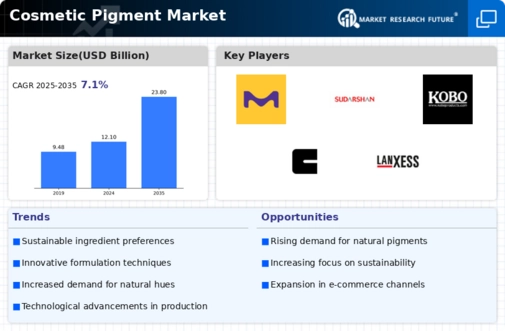Top Industry Leaders in the Cosmetic Pigments Market
 The cosmetic pigments market, where color dances on skin and lips, is a vibrant battlefield where artistry meets commerce. From established giants to nimble startups, players of all sizes wield their brushes to capture market share in this dynamic arena. Let's delve into the intricate layers of this market, exploring the strategies, factors influencing market share, recent developments, and its overall landscape.
The cosmetic pigments market, where color dances on skin and lips, is a vibrant battlefield where artistry meets commerce. From established giants to nimble startups, players of all sizes wield their brushes to capture market share in this dynamic arena. Let's delve into the intricate layers of this market, exploring the strategies, factors influencing market share, recent developments, and its overall landscape.
Strategies Adopted: Coloring the Competition:
-
Innovation Alchemists: Industry giants like BASF, Clariant, and Merck KGaA invest heavily in R&D, developing next-generation pigments with enhanced safety, vibrancy, and long-lasting wear. Think mineral-based pigments for sensitive skin, pigments derived from sustainable sources, and innovative light-diffusing options for luminous makeup effects.
-
Cost-Conscious Champions: Regional players like Shanghai Sanmu Chemical and Tianjin Rainbow Pigment focus on affordability, utilizing efficient production processes and readily available raw materials to cater to price-sensitive segments and emerging markets. This strategy ensures their pigments reach a wider audience.
-
Niche Specialists: Smaller players carve out their niches by specializing in specific pigment types or applications. Some focus on natural and organic pigments for the "clean beauty" market, while others cater to the growing demand for pigments for hair dyes and personal care products. This targeted approach allows them to excel in specialized areas.
Factors Fueling the Market Growth:
-
Beauty Boom: Rising disposable incomes and increasing spending on personal care products, particularly in emerging markets, drive the demand for diverse and high-quality cosmetic pigments. -
Social Media Buzz: The influence of social media and beauty influencers creates trends and promotes experimentation with bold colors and unique makeup looks, boosting the demand for versatile pigments. -
Personalization & Inclusivity: Growing emphasis on self-expression and inclusivity in the beauty industry fuels the need for a wider range of pigment shades and formulations to cater to diverse skin tones and preferences. -
Regulations & Safety: Stringent regulations on cosmetic ingredients necessitate the use of safe and compliant pigments, creating opportunities for manufacturers with certified formulas.
Key Players:
- Sun Chemical Corporation (U.S.)
- Sensient Cosmetic Technologies (France)
- Merck KGaA (Germany)
- Sudarshan Chemical Industries Limited (India)
- Kobo Products Inc (the U.S.)
- BASF SE (Germany)
- Clariant (Switzerland)
- Huntsman International LLC (U.S.)
- LANXESS (Germany)
- Geotech International B.V. (the Netherlands)
Recent Developments:
October 2023: BASF introduces a new line of long-lasting pigments with enhanced fade resistance, ideal for long-wear lipsticks and eye shadows.
November 2023: Clariant collaborates with a startup to develop biodegradable glitter pigments, addressing environmental concerns and creating a sustainable alternative for festive makeup.
December 2023: Merck KGaA expands its production capacity in North America, aiming to capitalize on the booming "clean beauty" trend and increased demand for natural pigments in the region.
January 2024: Shanghai Sanmu Chemical develops a pigment delivery system that reduces heavy metal content in makeup formulations, catering to consumer concerns about safety and offering a competitive edge.









